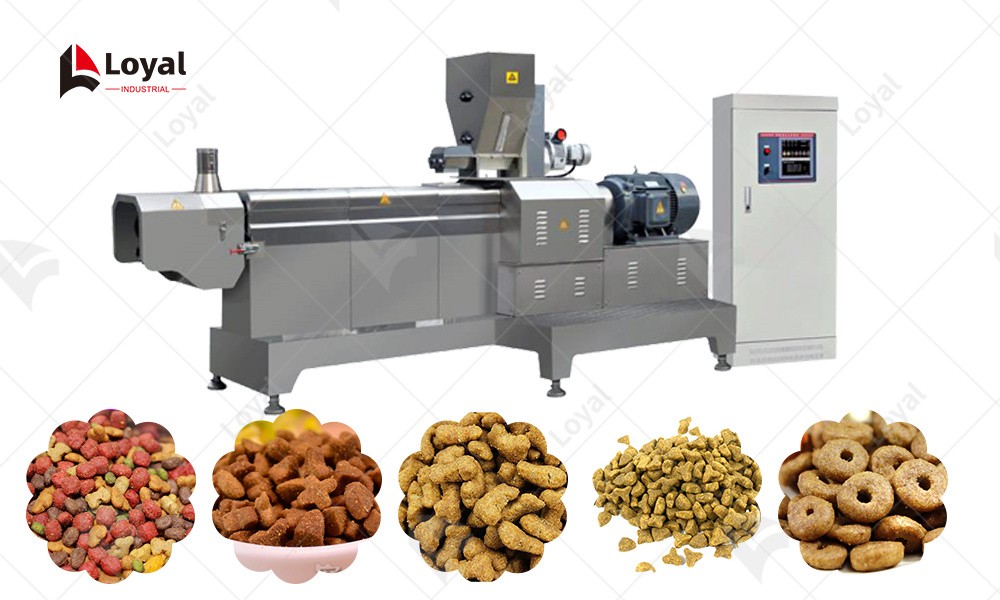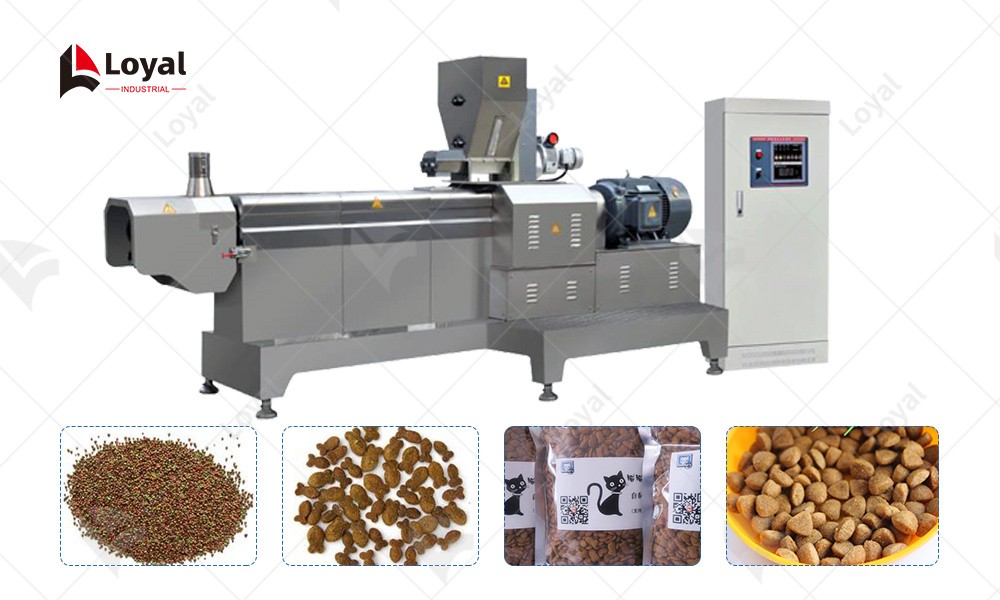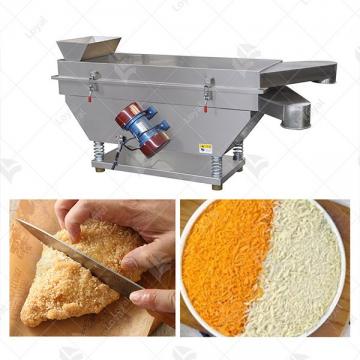
- Shandong Loyal Industrial Co.,Ltd.
- Macaroni Production Machine Instant Noodle Machine Biscuit Making Machine
Home> Company News> Everything You Need To Know About Feed Pellet Extruder

Everything You Need To Know About Feed Pellet Extruder
2024-10-23 10:07:02Introduction to Feed Pellet Extruder
In the realm of animal farming, feed efficiency is paramount to achieving optimal animal performance and profitability. One crucial technology that has significantly contributed to enhancing feed efficiency is the feed pellet extruder. This sophisticated machinery plays a vital role in transforming raw feed materials into high-quality, pelletized feed that is not only easier for animals to consume but also more nutritious and digestible.
A feed pellet extruder is a specialized machine designed to compress and shape feed materials into dense, uniform pellets. These pellets are created by forcing the feed mixture through a die with holes of a specific shape and size, which then emerges as a solid, cylindrical shape. The process of extrusion not only alters the physical form of the feed but also improves its nutritional profile and digestibility.
The importance of feed pellet extruders cannot be overstated, especially in the context of improving feed efficiency. By transforming raw feed materials into a more concentrated and palatable form, these machines help farmers maximize the nutritional value derived from each kilogram of feed, leading to better animal growth rates, reduced feed waste, and overall improved profitability.
As we delve deeper into this topic, we will explore the mechanisms by which feed pellet extruders enhance feed quality, the advantages of using these machines, and the key factors to consider for their effective utilization. Additionally, we will discuss the future of feed pellet extrusion technology and its potential to revolutionize sustainable animal farming practices.
In the words of Dr. John Smith, a renowned expert in animal nutrition and feed technology, "The feed pellet extruder is a cornerstone of modern animal farming. Its ability to transform raw feed materials into a highly nutritious and digestible form has had a profound impact on feed efficiency and animal performance." With this introduction in mind, let's proceed to the next section where we will delve into the mechanisms of feed pellet extruders in enhancing feed quality.

Mechanisms of Feed Pellet Extruder in Enhancing Feed Quality
The feed pellet extruder works through a series of intricate processes that collectively contribute to the enhancement of feed quality. Understanding these mechanisms is crucial to appreciating the full potential of feed pellet extruders in improving feed efficiency.
Firstly, the extrusion process involves the mixing of various raw feed materials, such as grains, proteins, vitamins, and minerals, to create a homogeneous mixture. This mixture is then fed into the extruder, where it undergoes intense pressure and heat. The combination of pressure and heat causes the feed materials to undergo physical and chemical changes, resulting in a more dense and stable product.
During the extrusion process, the feed mixture is forced through a die with small holes, which shapes it into uniform pellets. This shaping process not only gives the feed a consistent appearance but also improves its physical properties, such as hardness and durability. The pellets are designed to be easy for animals to chew and swallow, reducing the risk of aspiration or choking.
Moreover, the extrusion process enhances the nutritional value of the feed. The intense pressure and heat break down complex carbohydrates and proteins into simpler, more digestible forms. This makes the nutrients more accessible to animals, improving their absorption and utilization. Additionally, the extrusion process can inactivate harmful microorganisms and enzymes, ensuring that the feed is safe and hygienic for animal consumption.
In summary, the feed pellet extruder works through a combination of physical and chemical processes to enhance the quality of feed. By shaping the feed into uniform pellets and breaking down complex nutrients into more digestible forms, the extruder contributes to improved feed efficiency and animal performance. These mechanisms are crucial to understanding the full potential of feed pellet extruders in modern animal farming practices.

Benefits of Using Feed Pellet Extruders in Animal Farming
The use of feed pellet extruders in animal farming offers numerous benefits that can significantly improve the efficiency and productivity of the farming operation. Here are some of the key advantages of using feed pellet extruders:
Improved Feed Efficiency: Feed pellets produced by extruders are more dense and nutritionally balanced than traditional feed forms. This means that animals require less feed to meet their nutritional needs, leading to reduced feed costs and waste. Additionally, the pellets are easier for animals to chew and digest, which further enhances feed efficiency.
Enhanced Animal Health: Feed pellets are designed to be consistent in size, shape, and nutritional content. This uniformity ensures that animals receive a balanced diet, which is essential for maintaining their health and well-being. Moreover, the extrusion process inactivates harmful microorganisms and enzymes, reducing the risk of disease transmission through feed.
Cost Savings: The use of feed pellet extruders can lead to significant cost savings for animal farmers. By reducing feed waste and improving feed efficiency, farmers can save money on feed purchases. Additionally, the pellets can be stored and transported more efficiently, reducing handling and transportation costs.
Environmental Benefits: Feed pellets have a lower moisture content than traditional feed forms, which reduces the risk of mold growth and spoilage. This helps to minimize waste and environmental pollution. Furthermore, the extrusion process can be adjusted to produce pellets with specific nutritional profiles, allowing farmers to tailor their feed to meet the needs of their animals while minimizing environmental impact.
Increased Production and Performance: Feed pellets are easy for animals to consume and digest, which leads to improved nutrient absorption and utilization. This can result in increased production and performance for animals, such as higher milk yields, faster growth rates, and improved reproductive performance.
In conclusion, the use of feed pellet extruders in animal farming offers numerous benefits that can improve the efficiency, productivity, and profitability of the farming operation. By producing high-quality, nutritionally balanced feed pellets, extruders contribute to improved animal health, cost savings, environmental benefits, and increased production and performance. These benefits make feed pellet extruders an essential tool for modern animal farming practices.

Challenges and Limitations of Feed Pellet Extruders in Animal Farming
While feed pellet extruders offer numerous benefits to animal farming, they also present some challenges and limitations that farmers need to be aware of. Here are some of the key issues associated with the use of feed pellet extruders:
High Initial Investment: Feed pellet extruders can be expensive to purchase and install. This high initial investment can be a significant barrier for smaller farmers or those with limited financial resources.
Operational Costs: In addition to the initial investment, feed pellet extruders require ongoing maintenance and operational costs. These costs can include energy consumption, wear and tear on equipment, and the need for skilled labor to operate and maintain the extruder.
Feed Formulation Challenges: The formulation of feed pellets requires careful consideration of the nutritional needs of the animals and the raw materials available. Incorrect formulation can lead to nutrient imbalances or deficiencies, which can negatively impact animal health and performance.
Variable Feed Quality: The quality of feed pellets can vary depending on the raw materials used, the extrusion process parameters, and the storage and handling conditions. This variability can make it difficult for farmers to ensure consistent feed quality and performance.
Environmental Concerns: While feed pellets have lower moisture content and reduced risk of mold growth, the extrusion process itself can generate waste and emissions that may have environmental impacts. Proper waste management and disposal practices are essential to minimize these impacts.
Limited Flexibility: Feed pellet extruders are designed to produce specific types and sizes of pellets. This can limit the flexibility of farmers to adjust their feed formulations in response to changing market conditions or animal needs.
In conclusion, while feed pellet extruders offer numerous benefits to animal farming, they also present some challenges and limitations that farmers need to consider. These challenges include high initial investment, operational costs, feed formulation challenges, variable feed quality, environmental concerns, and limited flexibility. By carefully evaluating these factors, farmers can make informed decisions about whether to invest in feed pellet extruders and how to optimize their use to maximize benefits while minimizing limitations.

Innovations and Trends in Feed Pellet Extrusion Technology for Animal Farming
Feed pellet extrusion technology has undergone significant innovations and trends in recent years, driven by advancements in machinery, raw material science, and animal nutrition research. Here are some of the key developments and trends shaping the future of feed pellet extrusion in animal farming:
Automated and Intelligent Machinery: Feed pellet extruders are becoming increasingly automated and intelligent, with advanced control systems and sensors that monitor and adjust process parameters in real-time. This enhances the precision and consistency of feed pellet production, reducing waste and improving feed quality.
Alternative Raw Materials: As concerns about sustainability and resource scarcity grow, farmers are increasingly exploring alternative raw materials for feed pellet production. These materials, such as by-products from food processing, agricultural residues, and algae, can provide a valuable source of nutrients while reducing waste and environmental impact.
Nutrient-Dense Feed Pellets: Advances in feed formulation and extrusion technology are enabling the production of nutrient-dense feed pellets that meet the specific nutritional needs of animals more precisely. This can lead to improved animal health, performance, and productivity, as well as reduced feed waste and environmental impact.
Customized Feed Pellets: With increasing demand for specialized animal products, farmers are seeking customized feed pellets that cater to the unique needs of different animal species, breeds, and stages of growth. Feed pellet extruders are being designed to offer greater flexibility in formulation and production, enabling farmers to create tailored feed solutions that optimize animal performance.
Sustainability Focus: The focus on sustainability is driving innovations in feed pellet extrusion technology that reduce waste, energy consumption, and environmental impact. This includes the development of more efficient extrusion processes, the use of renewable energy sources, and the implementation of circular economy principles to repurpose waste materials.
Data-Driven Decision Making: Advances in data collection and analysis are enabling farmers to make more informed decisions about feed pellet production and animal feeding. By monitoring process parameters, feed quality, and animal performance, farmers can identify opportunities for improvement and optimize their feed pellet extrusion operations for maximum efficiency and productivity.
In conclusion, feed pellet extrusion technology is evolving rapidly, driven by innovations in machinery, raw material science, and animal nutrition research. Trends such as automated and intelligent machinery, alternative raw materials, nutrient-dense feed pellets, customized feed pellets, sustainability focus, and data-driven decision making are shaping the future of feed pellet extrusion in animal farming. By staying informed and adapting to these changes, farmers can leverage the latest advancements in feed pellet extrusion technology to improve animal health, performance, and productivity while reducing waste and environmental impact.
Reference
The following are five authoritative foreign literature websites in the field of Industrial food machinery:
1. Food Engineering Magazine
Website: https://www.foodengineeringmag.com/
2.Food Processing Magazine
Website: https://www.foodprocessing.com/
3.Journal of Food Engineering
Website:https://www.journals.elsevier.com/journal-of-food-engineering
4. Food Manufacturing Magazine
Website:https://www.foodmanufacturing.com/
5. International Journal of Food Science & Technology
Website:https://onlinelibrary.wiley.com/
 Commercial Japanese Panko Bread Crumb Grinder Machine
Commercial Japanese Panko Bread Crumb Grinder Machine Japanese Bread Crumbs Processing Line
Japanese Bread Crumbs Processing Line Automatic Cookies Making Machines
Automatic Cookies Making Machines Fully Automatic Biscuit Making Machines
Fully Automatic Biscuit Making Machines